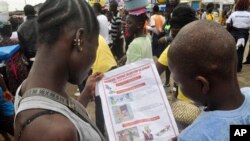The World Health Organization reported the number of cases in the West Africa Ebola outbreak will top nine-thousand this week. As of October 14, there have been 8,914 Ebola cases and 4,447 deaths have been reported to the agency.
The WHO gave an update on the crisis on Tuesday. The briefing was given by Dr. Bruce Aylward, WHO Assistant Director-General in charge of the operational response to the Ebola outbreak. He said that 95-percent of the cases are reported in 19 of the 67 districts, counties or prefectures in Guinea, Liberia and Sierra Leone -- a figure that’s held fairly steady for the past month.
“If we look at the reported number of cases over the last four weeks and we take seven day blocks for which we have full data, it’s been running about a thousand cases a week now for about three to four weeks. A couple of people have looked at that and said, well, what’s going on? Is the epidemic slowing down or are we not seeing the exponential growth? And quite frankly it’s too early to say. Because as most of you know these numbers go up and down. The lab sometimes can’t keep up with the amount of specimens they’re getting,” he said.
Another reason is health officials may be overwhelmed by the paperwork involved in tracking the epidemic. Dr. Aylward said there are some positive trends.
“One is a slowing down of the rate of new cases in some areas in what’s been the historic epicenter – Lofa County, Liberia. In both Kenema and Kailahun it’s been slowing down over the last couple of weeks, as well. Now, as some of you also know though, in Gueckedou, right across the border, we’ve seen the disease go up and down as well. But as we talk to our teams on the ground – there are teams from other organizations – there’s a lot of information that suggests that this is the result of real change in the behavior or the approach of communities most often.”
That behavior change includes a large increase in the number of safe burials. However, the WHO official has a warning for those who may say there are now just a few cases in those areas.
“Well, that’s like saying you’re only a little bit pregnant, you know. This is Ebola. This is a horrible, unforgiving disease. You’ve got to get to zero.”
To stop Ebola, he said, you need thorough tracing of those who may have been in contact with Ebola victims, same day isolation, among other things.
Aylward said that after visiting the region recently he also saw some disturbing trends. One is that the disease is expanding geographically.
“It’s important looking at a map where they’re coming up because they’re on the border areas, as well. With Cote d’Ivoire, in particular, we’re seeing some additional areas reporting cases that we hadn’t. So, that’s concerning – just that geographic expansion,” he said.
He’s also concerned about the number of cases in the capital cities. Recent figures are relatively flat, but it’s not clear whether that means control efforts are working.
“Any sense that the great effort that’s been kicked off over the last couple of months is already starting to see an impact – that would be really, really premature.”
Aylward said every district in the three worst affected countries must have full control over burials, casement management and behavior change. That’s not the case yet. He also said there is still a lack – of what he calls – real crisis management.
“It’s tough in crises because, as you know, it’s one thing if you’re running a military and have a command and control structure – it’s another thing when you’re running an awful lot of partners that are funded different ways. They have different accountabilities, et cetera, and you have to get them to common purpose. But there are things that can be done. Every country has got an emergency operating center or something to that effect. Often it’s a meeting. Everybody gets around the table and says what they’re doing. And you know what? I don’t care. What I care about is: here’s what has to be done – is someone doing all of those and does this all fit on the critical path that gets you to zero?”
The U.N. Mission for Ebola Emergency response, UNMEER, recently unveiled a strategy to reverse the upward trend in Ebola cases. It’s called the 70-70-60 plan. The aim is to have the training, treatment and logistics in place so there can be 70-percent safe burials and 70-percent of suspected cases isolated in 60-days. He admitted, however, that will be a difficult target to reach.
The WHO assistant director-general said while there is plenty of bleak news, there are some bright spots, including the ramping-up of the international response.











